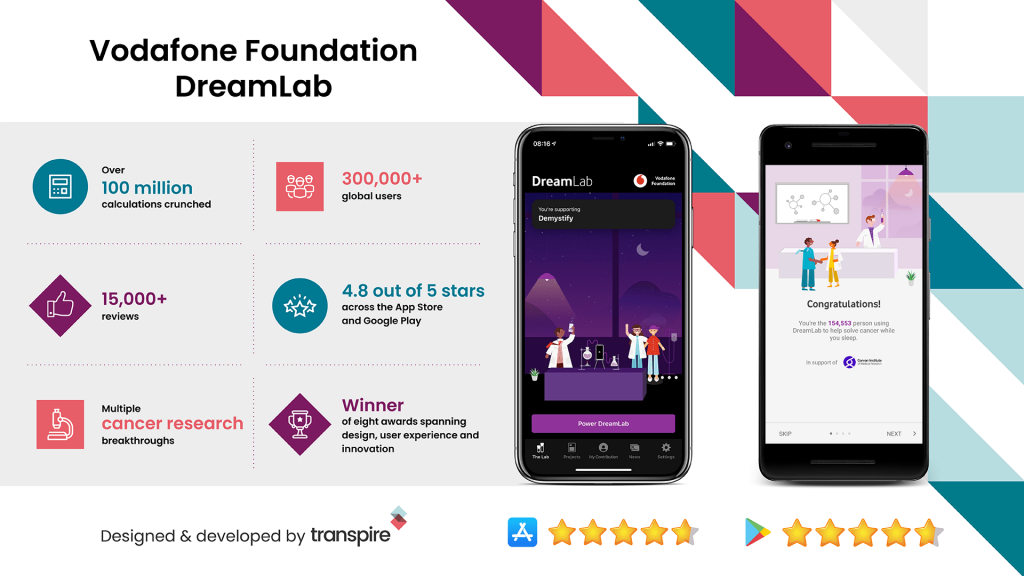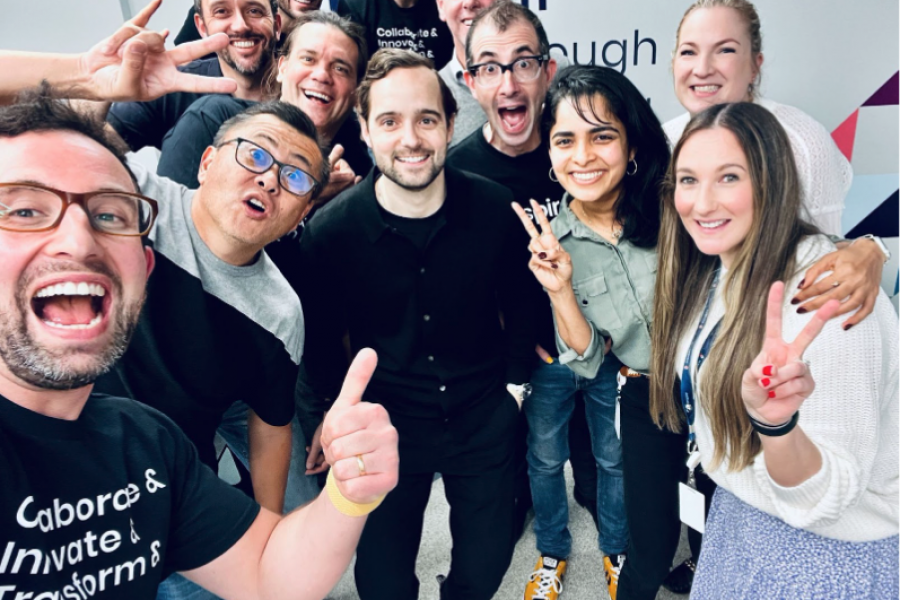Vodafone Foundation DreamLab – Australia’s first smartphone supercomputer that crunches cancer research data while users sleep – has been an ongoing project at Transpire since 2015.
To begin with, DreamLab was an exercise in technical feasibility, which required an architecture that supported large volumes of data and spiked traffic while remaining cost effective.
Then again, it also needed a minimalistic front-end with no barriers to participation, allowing as many users as possible to contribute to life-changing cancer research.
But as with every other successful project we’ve worked on at Transpire, a digital product’s initial launch is only the first step of a much longer journey.
With DreamLab, we’ve continued to add value to the project over the course of five years, improving the experience for users and helping Vodafone Foundation Australia meet its strategic goals.
The Value That Long-Term Projects Provide
Pivot easily for new features, better functionality and greater innovation
Because there is no fixed time or scope built into an ongoing project, the product owner is free to adjust their plans at very short notice. If a previously-unknown piece of work becomes a high priority, the product’s delivery team can easily pick up that piece of work in their upcoming sprint, or more quickly if the work is determined to be urgent.
For DreamLab, that means we can begin work on innovative new features soon after they are raised by the product owner, rather than worrying that they are out of project scope and require a change request or additional contract to deliver them.

Ensure relevance with continuous updates, improvements and refinements to the product backlog
As a result of shifting plans and priorities alongside a constantly evolving product, we continuously add to the project backlog as new work is required, and likewise prune the backlog on an ongoing basis when old work is no longer relevant.
The details of existing backlog items are also continuously updated to make sure that they are still reflective of the current product vision and relevant technical requirements. This is vital to ensure that we have an accurate view of the short, medium and long-term priorities that make up the planned future for the product.
All of this results in greater relevance for the product whenever updates, improvements and refinements are required.
Flexibility for the customer
For DreamLab, our plan for the future takes the form of a changing project roadmap. It describes the key priorities for the next 3-6 months, their estimated durations and completion dates, the associated releases, and the (usually external) dependencies in play in order to deliver those priorities on time.
As priorities shift or external readiness is achieved earlier or later than originally planned, key priorities can be moved up and down the roadmap to reflect these changes, and the rest of the roadmap can be adjusted accordingly.
For example, DreamLab works with a variety of international research partners, and if one of those research partners is ready to be onboarded earlier than originally expected, delivery timelines may be shifted to accommodate this. This is in contrast to shorter, fixed-term projects, where you would usually wait for the external requirements to be ready before starting delivery work.
Many releases = happier users
While a shorter, fixed-term project may only have one or two releases scheduled, an ongoing project will include many releases over time.
DreamLab often releases as regularly as every three weeks with minor updates, and usually releases more major updates every two months or so. Delivery work is largely structured around these many releases, which become successive milestones and deadlines that help to keep delivery focused and on track.
An ongoing project can easily change and adapt based on the success of its latest releases; elements that worked well can be expanded and replicated, and any elements that didn’t fully hit the mark can be improved or replaced.
Remaining up-to-date with the latest and greatest technology
Any ongoing, long-term project will need to update and adapt to external factors. Technology or design that was cutting edge a few years ago will need to be modernised for the present day. Apps need to be updated to run smoothly on new operating systems and new devices that didn’t exist when they originally launched.
Maintenance needs to be performed so that the app conforms to the latest app store requirements and the latest user expectations.
For DreamLab, we recently implemented an updated user experience as well as a new look and feel for the app. We are also planning a longer-term re-architecture, and regularly perform necessary maintenance activities.
Rotating team = different ideas, new perspectives and fresh impetus
Any project that has been running for a few years is unlikely to have exactly the same team as it started with.
For DreamLab, we usually rotate team members off the project after they have been working on it for 12 – 18 months. This helps our team members to stay engaged and efficient and prevents them from becoming burnt out on a single project.
New team members joining the project receive a robust on-boarding experience and, whenever possible, shadow the team member that they are replacing for weeks before the changeover officially occurs.
At Transpire, we deliver both shorter, fixed-term projects and long-term, ongoing projects. Regardless of the project’s length and shape, your digital product is in safe hands.
Watch out for multiple exciting updates to DreamLab in 2020, evolving an app that has already allowed hundreds of thousands of people to contribute the power of their smartphones to support cancer research.








